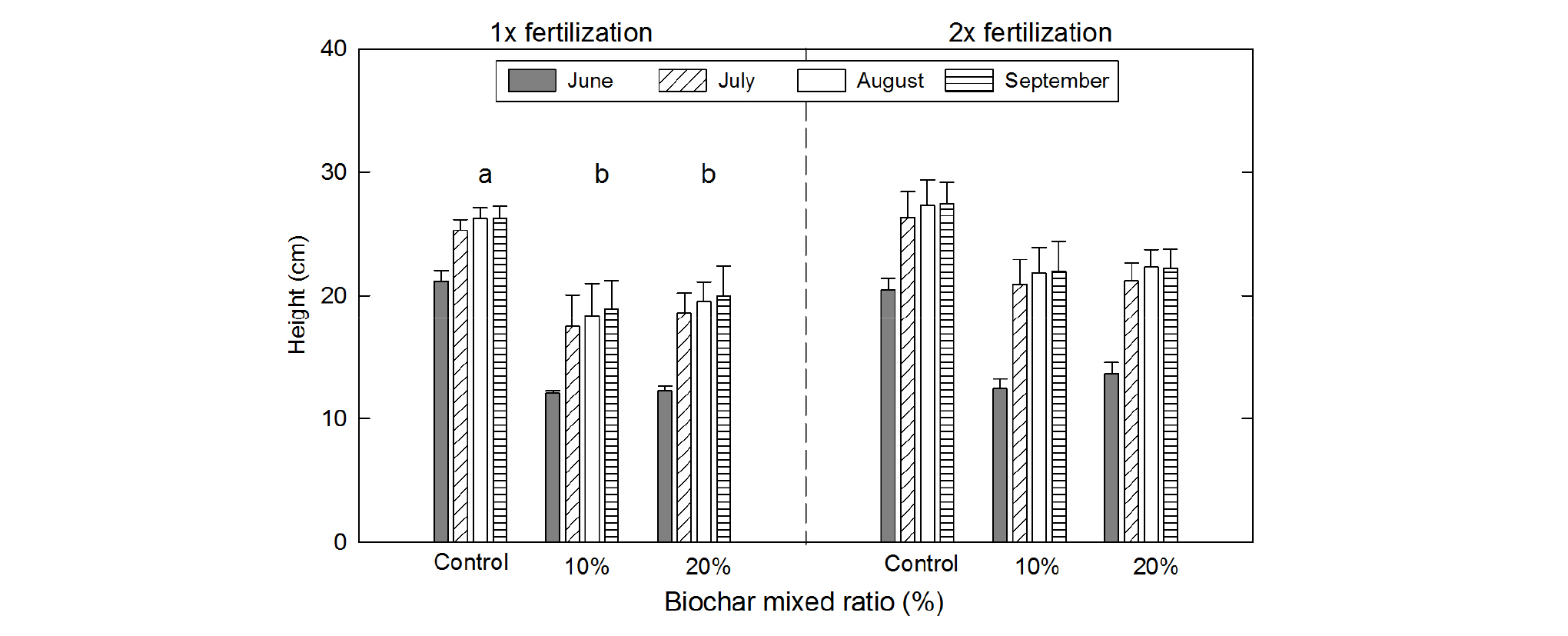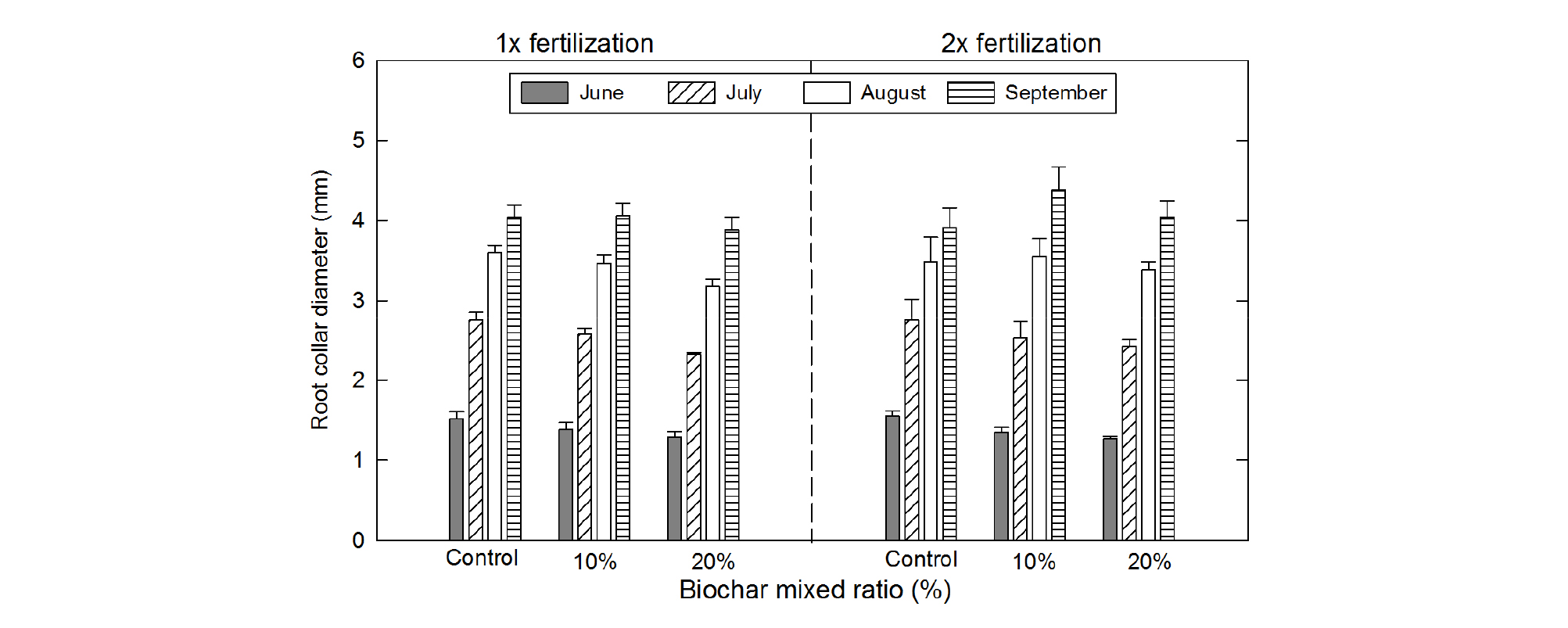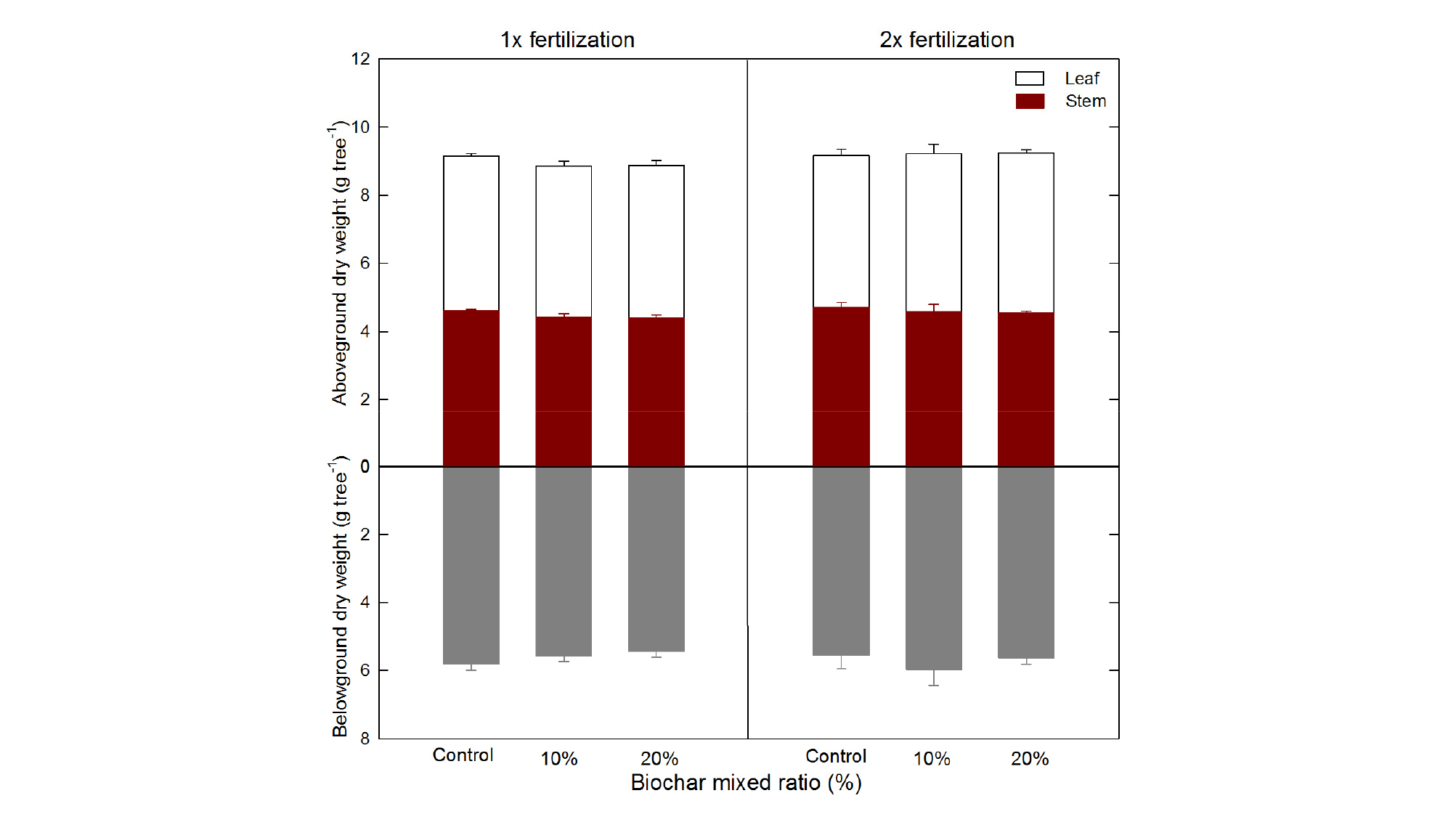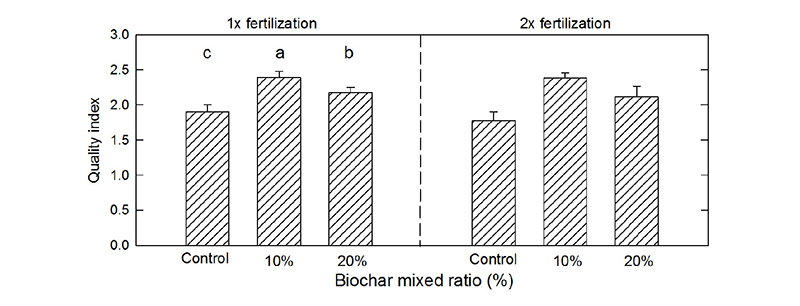Introduction
Materials and Methods
Results and Discussion
Introduction
바이오차는 농업 및 임업부산물, 가축 분뇨 또는 기타 유기성 폐기물을 산소가 적은 상태의 고온에서 생산한 일종의 탄화물질이다 (Bracmort, 2010). 이것은 농작물의 생산성을 증가시키고, 토양의 물리성과 화학성을 개량시키며, 토양에 탄소를 오랫동안 축적시킨다. 특히 농지에서 수분을 여과시키는 토양개량 첨가제로서 사용되어 왔고 (Lehmann and Joseph, 2009; Zhang et al., 2012), 임업 분야에서도 토양 개량에 사용될 수 있다. 바이오차의 탄소격리, 양분공급 및 석회시용효과 (liming effect)는 임지에서의 개벌 및 수확, 간벌 등과 같은 산림바이오매스 제거에 의해 잠재적으로 발생할 수 있는 부정적 영향을 완화시킬 수 있다 (McElligott et al., 2011). 그러나 바이오차의 효과에 대한 대부분의 연구는 농업 분야의 작물 생산성을 높이기 위해서 이루어졌기 때문에 (Oh et al., 2017), 바이오차를 임업 분야에 이용하기 위해서는 산림 수목에 미치는 영향에 대한 선행연구가 필요하다 (Wardle et al., 1998; Spokas et al., 2012).
바이오차의 특성은 원재료 (Lehmann, 2007; Downie et al., 2009; Cho et al., 2017)와 열분해공정 (pyrolysis)의 온도 및 시간에 따라 특성이 매우 달라진다 (Liang et al., 2006; Cheng et al., 2008; Downie et al., 2009; Watanabe et al., 2014). Yuan et al. (2011)에 의하면 볏짚을 이용해 500°C에서 제조된 바이오차가 같은 재료로 300°C에서 제조된 바이오차보다 토양 산도 개선에 효과가 더 크게 나타났다. 또한 바이오차가 적용된 토양의 특성에 따라 토양개량효과는 크게 달라지고 이는 식물에도 다양하게 영향을 미친다 (Amonette and Joseph, 2009). 최근 연구에 따르면 바이오차 처리가 활엽수 두 수종의 묘목품질지수 (seedling quality index)를 평균 14% 증가시켰는데, 이는 조림할 때 묘목의 초기 생존 확률을 높인 것과 관련이 있다고 한다 (Bayala et al., 2009; Aung et al., 2018). 또한, 미국 일리노이 주에서 시행된 연구에서는 바이오차와 질소 비료를 함께 시비한 곳에서 옥수수 수확량을 증대시키는 효과를 보였는데, 바이오차만 적용했을 때는 수확량이 20% 증가하였고, 질소 비료만 적용했을 때는 25% 증가, 질소 비료와 바이오차를 동시에 적용했을 때는 옥수수 수확량이 47% 증가하였다 (Zheng et al., 2010). 그러나 바이오차는 질소 고정 효율이 높은 토양과 알칼리성 토양에서는 토양 pH 증가 효과로 인해 토양 특성에 부정적 영향을 미치기도 한다 (Lehmann et al., 2003; Novak et al., 2009a). 이러한 효과는 원재료의 물리적, 화학적 및 생물학적 특성과 토양 및 식물 특이성의 상호작용에 달려 있다. Spokas et al. (2012)은 바이오차의 식물 생장에 대한 영향 연구들을 리뷰한 논문에서 바이오차 처리가 식물의 생장에 긍정적인 영향을 준 결과는 전체 연구에서 50%, 식물 생장에 유의한 차이를 보이지 않은 결과는 30%, 식물 생장을 감소시킨 결과는 20%였다고 보고하였다.
본 연구의 목적은 바이오차 혼합 비율이 경제림 조성 권장 수종인 산벚나무의 용기묘에 미치는 영향을 구명하는 것이다. 우리나라 자생수종인 산벚나무는 낙엽활엽교목으로 내한성이 강하여 전국 어디서나 식재가 가능하다. 생리생태적 특성으로 양수이며 습기가 많고 평탄한 비옥지에서 생육이 왕성하며, 대기오염에 저항성이 강하다 (Cho and Choi, 1992). 본 연구를 통해 상토대체재로서 참나무 숯의 이용가능성을 확인하여, 임업 부산물의 경제성을 높일 수 있는 기술을 제안할 수 있을 것이다.
Materials and Methods
연구지역 및 연구수종
본 연구는 대전에 위치한 충남대학교 학술림 (36゚22'N, 127゚21'E) 내 온실에서 실시하였으며, 온실의 연평균 기온은 22.5°C, 연평균 습도는 78.6%이다. 본 연구에서 사용된 수종은 산벚나무 (Prunus sargentii Rehder)이며, 국립품종관리센터에서 제공한 종자를 이용하였다. 2016년 3월 22일 경기도 포천의 국립산림과학원 산림기술경영연구소 온실에 파종하였고, 발아된 유묘를 2016년 4월 15일 충남대학교 온실로 가져와서 2016년 4월 21일 포트에 식재하여 연구를 실시하였다. 이후 연구는 식물의 생장이 이루어지는 기간을 고려하여 2016년 10월 4일까지 진행하였다.
실험설계
본 연구에서는 직경 6.8 cm, 깊이 15 cm로 용적 400 ml인 셀 (cell) 20개로 구성된 32 cm × 40 cm 용기 (tray)를 사용하였다. 연구의 편리성과 온실 내 공기 순환을 고려하여 모든 용기를 바닥에서 60 cm 높이의 용기받침대 위에 설치하였다. 바이오차 혼합 전의 기본 상토는 피트모스 (peatmoss), 펄라이트 (perlite), 질석 (vermiculite)을 1:1:1의 용적 비율로 혼합하여 사용하였는데(Table 1), 이는 용기묘 생산에 적합한 상토로 알려져 있다 (Landis et al., 1990). 실험 재료로는 1,200°C에서 제조된 참나무 숯 (바이오차)을 시중에서 구입하여 분쇄기로 직경 1 mm 이하로 분쇄한 뒤 실험에 사용하였다.
Table 1. The physical and chemical properties of the growing media before mixing with biochar (revised from Cho (2015)).
Bulk density
(g m-3)
|
pH
|
Electric
conductivity
(ds m-1)
|
Organic
matter
(%)
|
Total
N
(%)
|
P2O5
(mg kg-1)
|
Exchangeable cations
(cmolc kg-1)
|
CEC
(cmolc kg-1)
|
|
K+ |
Ca2+ |
Mg2+ |
|
0.37
|
6.1
|
0.06
|
4.0
|
0.08
|
3.0
|
0.3
|
3.3
|
2.5
|
24.3
|
바이오차 혼합 비율과 시비 처리에 따른 산벚나무의 반응을 구명하기 위해서 완전임의구역배치법 (completely randomized block design)을 사용하였으며, 3수준의 바이오차 혼합 비율과 2수준의 시비 처리를 각각 5반복 처리하였다.
바이오차를 혼합하지 않은 대조구는 400 ml 상토만을 사용하였고, 참나무 숯 40 ml를 상토 360 ml에 혼합하여 혼합 비율 10%로 만들고, 참나무 숯 80 ml를 상토 320 ml에 혼합하여 혼합 비율 20%로 사용하였다. 식재할 때는 간장과 근원경이 비슷한 유묘를 선별하여 사용하였으며, 식재 묘목 사이에 한 개의 빈 셀을 두어 용기 당 10개의 묘목을 식재하였다. 본 연구에서는 용기가 실험단위이고, 각각의 묘목이 관찰단위이다.
시비처리는 2016년 5월 24일부터 시작하여 생육기에 해당하는 10주 동안 일주일에 한 번씩 2수준으로 처리하였고, MultiFeed20 비료 (20N:20P2O5:20K2O, Haifa Chemical, Israel)를 용해시켜 사용하였다. ‘2x’ 시비는 산림청 종묘사업실시요령의 표준량에 해당하는 양으로 1 g/L MultiFeed20을 물에 용해시켜 각 셀 당 110 ml씩 관수하였고, 표준량의 50%에 해당하는 ‘1x’ 시비는 0.5 g/L MultiFeed20 비료를 용해시켜 처리하였다. 매일 20분 동안 오전에 자동관수를 실시하였고, 관수량 또는 햇빛 양과 같은 온실 내 발생할 수 있는 환경변인을 제거하기 위해 용기의 위치를 2주마다 순환하여 재배치하였다.
생장측정
실험 기간 동안 바이오차 혼합 비율 및 시비 처리에 따른 용기묘의 간장과 근원경 생장을 매월 측정하였다. 간장은 상토 지면으로부터 정아 끝 분열조직까지 측정하였고, 근원경은 지면 1 cm 높이에서 측정하였다 (Han et al., 2016). 바이오매스를 측정하기 위해 10월에 묘목을 줄기, 잎 및 뿌리로 나누어 수확하였고, 뿌리는 토양 입자를 제거하기 위해 흐르는 수돗물로 3회 세척하였다. 분리된 식물 조직은 건조기를 사용하여 65°C에서 48시간 동안 건조시킨 후 건중량을 측정하였다.
묘목품질지수 (Dickson’s quality index)
묘목의 간장, 근원경 등 단편적 생장특성으로 묘목의 품질을 평가하고, 조림 후 생장을 정확하게 예측하기에는 어려움이 있다. Dickson은 묘목의 전체 생장량인 건중량, 지상부와 지하부의 배분 비율과 수고와 근원경의 비율을 동시에 고려하는 묘목품질지수를 제시하였다 (Dickson et al., 1960; Iyer and Wilde, 1982; Cho and Hwang, 2016). 묘목의 품질지수를 나타내는 Seedling quality index (SQI)는 값이 높을수록 건전한 묘목으로 평가받는다 (Thompson, 1985; Jin et al., 2015). 본 실험에서는 묘목의 품질을 측정하기 위해 Dickson의 품질지수 (Quality Index, QI) 공식인 QI = SD/(HD+TR)를 사용하였다. SD는 묘목의 총 건중량 (g), HD는 간장 (cm)과 근원경 (mm)의 비율, TR는 지상부 건중량 (g)과 지하부 건중량 (g)의 비율을 나타낸다 (Dickson et al., 1960; Deans et al., 1989; Bayala et al., 2009; Cho et al., 2017).
통계분석
바이오차 혼합 비율 3수준과 시비 처리 2수준이 묘목의 수고, 근원경, 건중량 및 품질지수에 미치는 영향을 Duncan의 다중비교검정을 이용하여 분산분석 (ANOVA) 하였다. 각 처리에 따른 간장과 근원경의 월별 생장 변화는 일원분산분석 (One-way ANOVA)으로 분석하였으며, 모든 확률은 유의수준 0.05를 기준으로 검증하였다.
Results and Discussion
바이오차 혼합 비율과 시비 처리는 산벚나무 묘목의 간장과 근원경 생장에 유의하게 상호작용하지 않았다 (Table 2). 그러나 주요인 (main factor)인 혼합 비율은 묘목의 간장 생장에 유의한 영향을 미쳤다; 묘목의 간장은 대조구에 비해 10%와 20% 혼합 비율 처리에서 유의하게 낮았으며, 1x 시비 처리보다 2x 시비 처리에서 생장이 높았지만 통계적 유의성은 없었다 (Fig. 1). 또한, 근원경 생장에 바이오차 혼합 비율과 시비 처리 주요인은 유의한 영향을 미치지 않았다 (Fig. 2). 그리고 간장과 근원경의 생장처럼 두 처리가 산벚나무의 잎, 줄기 및 뿌리의 바이오매스에 미치는 상호작용효과도 유의하지 않았으며 (Table 2), 바이오매스 생장에 미치는 바이오차 혼합 비율과 시비 처리 효과도 없었다 (Fig. 3).
Table 2. ANOVA table for growth parameters of Prunus sargentii on biochars mixed ratio and fertilization treatments.
|
Source of variable
|
Degree of
freedom
|
Probability (Pr > F)
|
|
Height
|
Root collar
diameter
|
Dry weight
|
Quality index
|
|
Leaf
|
Stem
|
Root
|
Total
|
|
Mixed ratio
|
2
|
<0.01
|
0.39
|
0.86
|
0.27
|
0.70
|
0.90
|
<0.01
|
|
Fertilization
|
1
|
0.19
|
0.49
|
0.42
|
0.20
|
0.63
|
0.44
|
0.47
|
|
Mixed ratio × Fertilization
|
2
|
0.89
|
0.54
|
0.62
|
0.97
|
0.55
|
0.66
|
0.84
|

Fig. 1.
Seedling height (cm) for 1x fertilization (left) and 2x fertilization (right) by the mixed ratio of oak biochar. Different letters represent significant differences among mixed ratios in both fertilization treatments. Vertical bars represent one standard error of the mean (n = 5).

Fig. 2.
Seedling root collar diameter (mm) for 1x fertilization (left) and 2x fertilization (right) by the mixed ratio of oak biochar. Vertical bars represent one standard error of the mean (n = 5).

Fig. 3.
Leaf, stem, and root dry weight for 1x fertilization (left) and 2x fertilization (right) by the mixed ratio of oak biochar. Vertical bars represent one standard error of the mean (n = 5).
바이오차 처리에 의한 묘목의 수고, 근원경 및 건중량의 초기 감소현상은 다른 연구에서도 보고되고 있는데, Cho et al. (2017)과 Han et al. (2017)은 20% 혼합 비율 처리가 느티나무와 물푸레나무 묘목의 수고와 근원경을 유의하게 감소시킨다고 보고하였고, Haefele et al. (2011)은 탄화왕겨로 만든 바이오차를 벼에 처리했을 때 벼의 초기 생장을 유의하게 감소시킨다고 보고하였다. 이는 바이오차 처리가 pH와 같은 토양 특성에 영향을 주고 (Lehmann et al., 2003; Chan et al., 2008; Novak et al., 2009a; Novak et al., 2009b), 그로 인해 식물체의 양분 흡수 또는 생리적 반응에 부정적인 역할을 한 것으로 판단된다 (Linnartz, 1963; Chung et al., 1980; Chan and Xu, 2009).
묘목품질지수의 경우 혼합 비율과 시비 처리의 상호작용 효과는 없었으나, 혼합 비율 10% 처리 묘목이 대조구에 비해 품질지수를 26% 향상시키며 유의한 차이를 보였고, 시비 처리는 생장 반응과 마찬가지로 품질지수에 유의한 영향을 미치지 않았다 (Fig. 4). 이러한 결과는 바이오차 혼합 처리에서 간장 대 근원경의 비율이 감소하여 품질지수가 증가한 것에 기인한 것으로, 묘목 식재 후 활착률과 초기 생장을 증가시킬 것이다 (Mullin and Christl, 1982). 묘목의 품질을 평가할 때 주로 수고와 근원경이 이용되고 있지만, 이것들이 항상 정확하게 예측할 수 있는 것은 아니다 (Chavasse, 1977; Thompson and Schultz, 1995; Jacobs et al., 2005). 이에 반해 묘목의 뿌리 바이오매스와 생리적 상태는 묘목의 이식 후 생존 가능성을 판단하는 지표로 사용할 수 있다 (Davis and Jacobs, 2005). 용기묘는 용기의 형태 및 크기, 상토의 종류에 따라 뿌리 발달이 다른데, 형태적 및 생리적으로 좋은 뿌리 체계를 가진 묘목은 조림 초기에 빠른 활착과 높은 생장을 기대할 수 있다 (Duryea, 1985; Mattsson, 1997). 용기묘 생산 시 상토에 첨가된 바이오차는 묘목의 뿌리에 적정한 생육 환경을 개선시켜 수분 보유력과 통기성 증진 등 긍정적인 효과를 얻을 수 있는 것으로 판단된다 (Lehmann et al., 2003; Steiner et al., 2007; Graber et al., 2010; Altland and Krause, 2012; Cernansky, 2015; Rezende et al., 2016). 특히, 근원경과 뿌리밀도는 조림 후 뿌리의 생장 잠재력과 비례하고 (Mullin and Christl, 1982; Rose et al., 1991), 이러한 뿌리의 생장 잠재력이 우수한 묘목은 수분이용능력이 높기 때문에 조림 후 높은 활착률을 나타낸다 (Carlson, 1986; Cho and Hwang, 2016).

Fig. 4.
Seedling quality index for 1x fertilization (left) and 2x fertilization (right) by the mixed ratio of oak biochar. Different letters represent significant differences among mixed ratios in both fertilization treatments. Vertical bars represent one standard error of the mean (n = 5).
본 연구에서는 야외에서 조림 후 초기 활착률을 검증하는 연구는 실시하지 않았다. 그러나, 위에서도 언급하였듯이 묘목품질지수에 근거하면 바이오차 10% 혼합 비율 처리에서 생산된 묘목의 증가된 근원경과 뿌리 바이오매스는 초기 활착과 생장을 향상시킬 것이다 (Duryea, 1985; Carlson, 1986; Mattsson, 1997). 따라서 참나무 숯 처리가 산벚나무의 생장 메커니즘에 미치는 영향에 대한 구명과 산림 부산물의 상토 대체효과 가능성 및 조림 초기에 미치는 영향에 대한 추가적인 연구가 추후 요구된다.
Acknowledgements
This study was partially carried out with the support of Research Fund provided by Chungnam National University.
References
Altland, J.E. and C.R. Krause. 2012. Substituting pine wood for pine bark affects physical properties of nursery substrates. HortScience. 47(10):1499-1503.
Amonette, J.E. and S. Joseph. 2009. Characteristics of biochar: micro-chemical properties, p. 33-52. In: Lehmann, J. and S. Joseph (ed.). Biochar for Environmental Management: Science and Technology. Earthscan. London, UK.
Aung, A., S.H. Han, W.B. Youn, L. Meng, M.S. Cho, and B.B. Park, 2018. Biochar effects on the seedling quality of
Quercus serrata and
Prunus sargentii in a containerized production system. For. Sci. Technol. 14(3):112-118.
Bayala, J., M. Dianda, J. Wilson, S.J. Ouedraogo, and K. Sanon. 2009. Predicting field performance of five irrigated tree species using seedling quality assessment in Burkina Faso, West Africa. New Forest. 38(3):309-322.
Bracmort, K. 2010. Biochar: examination of an emerging concept to mitigate climate change. Congressional Research Service, WA, USA.
Carlson, W.C. 1986. Root system considerations in the quality of loblolly pine seedlings. South. J. Appl. For. 10:87-92.
Cernansky, R. 2015. State-of-the-Art Soil. Nature. 517(7534):258.
Chan, K.Y. and Z. Xu. 2009. Biochar: nutrient properties and their enhancement, p.67-84. In: Lehmann, J. and S. Joseph (ed.). Biochar for Environmental Management: Science and Technology. Earthscan. London, UK.
Chan, K.Y., Z.L. Van, I. Meszaros, A. Downie, and S. Joseph. 2008. Using poultry litter biochars as soil amendments. Soil Res. 46(5):437-444.
Chavasse, C.G.R. 1977. The significance of planting height as an indicator of subsequent seedling growth. New Zeal. J. For. 22:283-296.
Cheng, C.H., J. Lehmann, and M.H. Engelhard. 2008. Natural oxidation of black carbon in soils: Changes in molecular form and surface charge along a climosequence. Geochim. Cosmochim. Ac. 72(6):1598-1610.
Cho, M.S. 2015. Effects of growing density and cavity volume of container on growth performances and physiological characteristics of major temperate broad-leaved tree species in nursery and plantation stage. Ph.D. Thesis, Chungnam National University, Daejeon, Korea. (in Korean, with English Abstract)
Cho, M.S. and J.H. Hwang. 2016. Development of optimal container type for tree species in container nursery system. National Institute of Forest Science, Seoul, Korea. (in Korean)
Cho, M.S., L. Meng, J.H. Song, S.H. Han, K.K. Bae, and B.B. Park. 2017. The effects of biochars on the growth of
Zelkova serrata seedlings in a containerized seedling production system. For. Sci. Technol. 13(1):25-30.
Cho, M.Y. and M.S. Choi. 1992. Illustrated Woody Plants of Korea. Korea Forest Service, Forestry Research Institute, Seoul, Korea. (in Korean)
Chung, Y.G., B.W. Hong, and J.M. Kim. 1980. Relation between chemical properties of soil and tree growth. J. Kor. For. Soc. 46:10-20. (in Korean)
Davis, A.S. and D.F. Jacobs. 2005. Quantifying root system quality of nursery seedlings and relationship to outplanting performance. New Forest. 30(2):295-311.
Deans, J.D., W.L. Mason, M.G.R. Cannell, A.L. Sharpe, and L.J. Sheppard. 1989. Growing regimes for bare-root stock of Sitka Spruce, Douglas-Fir and Scots Pine. 1. Morphology at the end of the nursery phase. Forestry. 62:53-60.
Dickson, A., A.L. Leaf, and J.F. Hosner. 1960. Quality appraisal of white spruce and white pine seedling stock in nurseries. The Forestry Chronicle. 36(1):10-13.
Downie, A., A. Crosky, and P. Munroe. 2009. Physical properties of biochar, p. 13-32. In: Lehmann, J. and S. Joseph (ed.). Biochar for Environmental Management: Science and Technology. Earthscan, London, UK.
Duryea, M.L. 1985. Evaluating seedling quality: importance to reforestation, p. 1-4. In: Duryea, M.L. (ed.). Evaluating Seedling Quality: Principles, Procedures, and Predictive Abilities of Major Tests. Forest Research Laboratory, Oregon State University, Corvallis, USA.
Graber, E.R., Y.M. Harel, M. Kolton, E. Cytryn, A. Silber, D.R. David, L. Tsechansky, M. Borenshtein, and Y. Elad. 2010. Biochar impact on development and productivity of pepper and tomato grown in fertigated soilless media. Plant Soil. 337(1-2):481-496.
Haefele, S.M., Y. Konboon, W. Wongboon, S. Amarant, A.A. Maarifat, E.M. Pfeiffer, and C. Knoblauch. 2011. Effects and fate of biochar from rice residues in rice-based systems. Field Crop. Res. 121(3):430-440.
Han, S.H., J.K. Byun, M.S. Cho, J.Y. An, G.S. Park, S.B. Kim and B.B. Park. 2016. The Effects of 7 Fertilizers on the Growth and Nutrient Concentrations of
Fraxinus rhynchophylla, Fraxinus mandshurica, Pinus koraiensis, and
Abies holophylla Seedlings. J. Kor. For. Soc. 105(2):177-185. (in Korean)
Han, S.H., L. Meng, A. Rahman, Y.T. Ko, M.S. Cho, and B.B. Park. 2017. Torrefied wood effects on the seedling quality of
Zelkova serrata and
Fraxinus rhynchophylla in a containerized production system. For. Sci. Technol. 13(4):145-151.
Iyer, J.G. and S.A. Wilde. 1982. A quick way to appraise the performance potential of tree planting stock. Tree Planters' Notes. 33:26-27.
Jacobs, D.F., K.F. Salifu, and J.R. Seifert. 2005. Relative contribution of initial root and shoot morphology in predicting field performance of hardwood seedlings. New Forest. 30(2):235-251.
Jin, E.J., J.H. Yoon, E.J. Bae, S.M. Choi, Y.B. Park, and M.S. Choi. 2015. Effect of above and below-ground container cultivation on growth of
Quercus glauca 4 years old seedlings. J. Agr. Life Sci. 49(6):9-17. (in Korean, with English Abstract)
Landis, T.D., R.W. Tinus, S.E. McDonald, and J.P. Barnett. 1990. Containers and growing media, Vol. 2 of The Container Tree Nursery Manual, Agricultural Handbook 674. USDA, FS, WA, USA.
Lehmann, J. 2007. Bio-energy in the black. Front. Ecol. Environ. 5(7):381-387.
Lehmann, J. and S. Joseph. 2009. Biochar for environmental management: An introduction, p. 1-12. In: Lehmann, J. and S. Joseph (ed.). Biochar for Environmental Management: Science and Technology. Earthscan. London, UK.
Lehmann, J., J.P. da Silva, C. Steiner, T. Nehls, W. Zech, and B. Glaser. 2003. Nutrient availability and leaching in an archaeological Anthrosol and a Ferralsol of the Central Amazon basin: fertilizer, manure and charcoal amendments. Plant Soil. 249(2):343-357.
Liang, C., Z. Dang, B. Xiao, W. Huang, and C. Liu. 2006. Equilibrium sorption of phenanthrene by soil humic acids. Chemosphere. 63(11):1961-1968.
Linnartz, N.E. 1963. Relation of soil and topographic characteristics to site quality for southern pines in the Florida parishes of Louisiana. J. Forest. 61(6):434-438.
Mattsson, A. 1997. Predicting field performance using seedling quality assessment. New Forest. 13(1-3):227-252.
McElligott, K., D. Page-Dumroese, and M. Coleman. 2011. Bioenergy production systems and biochar application in forests: Potential for renewable energy, soil enhancement, and carbon sequestration. USDA, FS, RMRS, CO, USA.
Mullin, R.E. and C. Christl. 1982. Morphological grading of white pine nursery stock. The Forestry Chronicle. 58:40-43.
Novak, J.M., I. Lima, B. Xing, J.W. Gaskin, C. Steiner, K.C. Das, M. Ahmenda, D. Rehrah, D.W. Watts, W.J. Busscher, and H. Schomberg. 2009a. Characterization of designer biochar produced at different temperatures and their effects on a loamy sand. Ann. Environ. Sci. 3(2):195-206.
Novak, J.M., W.J. Busscher, D.L. Laird, M. Ahmedna, D.W. Watts, and M.A.S. Niandou. 2009b. Impact of biochar amendment on fertility of a southeastern coastal plain soil. Soil Sci. 174(2):105-112.
Oh, T.K., J.H. Lee, S.H. Kim, and H.C. Lee. 2017. Effect of biochar application on growth of Chinese cabbage (
Brassica chinensis). Kor. J. Agr. Sci. 44(3):359-365. (in Korean, with English Abstract)
Rezende, F.A., V.A.H.F.D. Santos, C.M.B.D.F. Maia, and M.M. Morales. 2016. Biochar in substrate composition for production of teak seedlings. Pesq. Agropec. Bras. 51(9):1449-1456.
Rose, R., J. Gleason, M. Atkinson, and T. Sabin. 1991. Grading ponderosa pine seedlings for outplanting according to their root volume. West. J. Appl. For. 6(1):11-15.
Spokas, K.A., K.B. Cantrell, J.M. Novak, D.W. Archer, J.A. Ippolito, H.P. Collins, A.A. Boateng, I.M. Lima, M.C. Lamb, A.J. McAloon, R.D. Lentz, and K.A. Nichols. 2012. Biochar: a synthesis of its agronomic impact beyond carbon sequestration. J. Environ. Qual. 41(4):973-989.
Steiner, C., W.G. Teixeira, J. Lehmann, T. Nehls, J.L.V. de Macedo, W.E.H. Blum, and W. Zech. 2007. Long term effects of manure, charcoal and mineral fertilization on crop production and fertility on a highly weathered Central Amazonian upland soil. Plant Soil. 291(1-2):275-290.
Thompson, B.E. 1985. Seedling morphological evaluation what you can tell by looking. p.59-71. In: Durvea, M.L. (ed.). Evaluation seedling quality: Principles, Procedures, and Predictive Abilities of Major Tests. Oregon State University, Forestry Research Laboratory, OR, USA.
Thompson, J.R. and R.C. Schultz. 1995. Root system morphology of
Quercus rubra L. planting stock and 3-year field performance in Iowa. New Forest. 9(3):225-236.
Wardle, D.A., O. Zackrisson, and M.C. Nilsson. 1998. The charcoal effect in Boreal forests: mechanisms and ecological consequences. Oecologia. 115(3):419-426.
Watanabe, T., A. Shino, K. Akashi, and J. Kikuchi. 2014. Chemical profiling of Jatropha tissues under different torrefaction conditions: application to biomass waste recovery. PLoS ONE. 9(9):e106893.
Yuan, J.H., R.K. Xu, and H. Zhang. 2011. The forms of alkalis in the biochar produced from crop residues at different temperatures. Bioresource. Technol. 102(3):3488-3497.
Zhang, A., R. Bian, G. Pan, L. Cui, Q. Hussain, L. Li, Ji. Zheng, Ju. Zheng, X. Zhang, X. Han, and X. Yu. 2012. Effects of biochar amendment on soil quality, crop yield and greenhouse gas emission in a Chinese rice paddy: a field study of 2 consecutive rice growing cycles. Field Crop. Res. 127:153-160.









